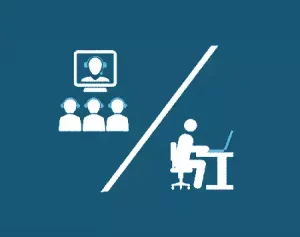Learning on your time through asynchronous learning can make second language learning more stress-free and cost-effective. The landscape of language learning has undergone a significant transformation in recent years. The rise of online platforms and digital resources has introduced a new dimension to second language acquisition (SLA), with asynchronous learning emerging as a valuable tool for educators and learners alike. This article explores the unique benefits of asynchronous learning for SLA and argues for its integration into a comprehensive language learning approach.
Video on learning on your time through asynchronous learning
Traditional Limitations and the Asynchronous Advantage

Traditional, classroom-based language learning often struggles to cater to individual learning styles and paces. Synchronous sessions or live classes, where everyone learns at the same time, can be restrictive for learners who require more time to process information or overcome anxieties about speaking in front of others. These anxieties can lead to reduced participation and hinder language development. Asynchronous learning, on the other hand, offers a solution by providing learners with greater control over their learning experience.
Benefits of Asynchronous Learning for SLA

Asynchronous activities offer a treasure trove of benefits for SLA. Online discussions, spaced repetition tools, and self-paced video lessons and multimedia through flipped learning allow learners to focus on areas requiring more attention and revisit lessons as needed. This personalized approach caters to individual learning styles. Visual learners can benefit from video lessons and infographics, while auditory learners can thrive with audio recordings and podcasts. Kinesthetic learners can find value in interactive exercises and simulations. By catering to these diverse learning preferences, asynchronous resources promote deeper understanding and knowledge retention.
Reduced Anxiety and Increased Confidence
The pressure to perform in a fast-paced classroom setting can be detrimental to language acquisition. Asynchronous tasks like written assignments, pronunciation recordings, and self-assessments can be completed in a low-pressure environment. This allows learners to experiment with the language, make mistakes without fear of public judgment, and receive feedback at their own pace. This fosters a more relaxed and confident learning experience, essential for overcoming inhibitions and developing fluency.
Development of Autonomy and Reflective Learning

Asynchronous learning empowers learners to take ownership of their learning journey. By actively engaging with resources, setting personal goals, and reflecting on their progress through tools like learning journals and online portfolios, learners develop autonomy and metacognitive skills. Metacognition refers to “thinking about thinking,” the ability to reflect on and analyze one’s own learning processes. Asynchronous learning encourages learners to become more strategic and independent in their approach to language acquisition.
Accessibility and Flexibility

Learners can access asynchronous materials and participate in discussion forums at their convenience, regardless of location or time constraints. This flexibility is particularly beneficial for busy adults juggling work and family commitments, learners with disabilities who may require additional time to complete tasks, or those in geographically dispersed regions with limited access to traditional language courses. Asynchronous learning removes these barriers to entry and provides a more inclusive learning environment.
Examples of Effective Asynchronous Activities

The possibilities for engaging asynchronous activities in SLA are vast. Here are a few examples:
Online Discussions
Asynchronous forums and discussion boards allow learners to engage in written conversations on various topics, practice formulating grammatically correct sentences, and explore diverse viewpoints. This collaborative environment fosters peer-assessment, critical thinking, and cultural understanding.
Multimedia Learning Resources

Interactive websites, mobile apps, and educational games can make learning engaging and enjoyable. These resources can provide vocabulary building exercises, grammar drills, pronunciation practice activities, and cultural insights – all accessible at the learner’s convenience. To exemplify this point, on LELB Society, our students do not need to take numerous online classes based on synchronous learning to learn Persian or English. Alternatively, they can opt for monthly subscription on our WordPress membership website to access English and Persian resources with videos, comment forms, and our full support 24/7.
Spaced Repetition Tools
Software applications based on spaced repetition algorithms can significantly improve vocabulary retention. These tools present learners with new words at increasingly spaced intervals based on their learning progress, optimizing memorization and recall. For instance, at LELB Society, ESL students can master over 2800 English vocabulary in context with visuals. Furthermore, at the bottom of each lesson on our website, our English and Persian students can further their study with visually related posts and lessons that are selected based on the used tags in the current post.

Self-Paced Video Lessons and Tutorials
Video lessons allow learners to learn grammar structures, vocabulary, and pronunciation at their own pace. The ability to pause, rewind, and re-watch specific sections caters to individual learning styles and ensures comprehension. It’s important to note that the use of video tutorials, lectures, and multimedia is one of the cornerstones of flipped learning.

Being a bilingual academy of English and Persian, LELB Society is making great use of flipped learning by creating thousands of educational videos and uploading them on LELB Society’s YouTube channel. These video tutorials, lectures, narrations, and the like are then embedded in the body of 4300 English and Persian lessons for self-study to account for flipped learning.

Self-Directed Projects
Asynchronous learning environments can provide learners with opportunities to explore topics of personal interest and create multimedia projects like presentations, podcasts, or short videos. This encourages independent research, critical thinking, and the integration of newly acquired language skills into meaningful tasks.
Optimizing Asynchronous Learning for SLA

While asynchronous learning offers significant advantages, it is crucial to integrate it strategically with other approaches to create a well-rounded learning experience. Here are some key considerations:
Balancing Asynchronous and Synchronous Activities

Combine self-paced learning with opportunities for real-time genuine interaction with teachers and peers. Synchronous sessions, such as video conferencing or online chat rooms, foster collaboration, communication skills development, and provide immediate feedback. This blended approach leverages the strengths of both synchronous and asynchronous learning to create a comprehensive language learning program. That’s why in our online English and Persian classes, we encourage our students to study the assigned materials, watch the embedded videos, and leave comments in our asynchronous modes of communication, namely comment forms and discussion boards before the following live classes through synchronous learning.
Creating Engaging Asynchronous Activities

Design tasks that are interactive, thought-provoking, and cater to different learning styles. This can include multimedia resources, collaborative forums with a stimulating User Interface (UI), and above all, interesting and challenging topics or themes. By referring to the popular tags in our lessons on LELB Society, you’ll realize that these tags or topics are meticulously selected on the basis of content-based instruction or CBI. That is to say, the team of our educators and content developers endeavor to utilize challenging, useful, and interesting topics and themes for the curious and independent L2 learners of the third millennium in the metaverse era, such as the following:



